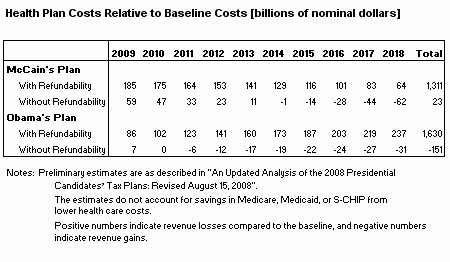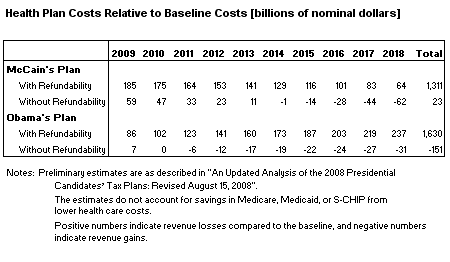The voices of Tax Policy Center's researchers and staff

In a previous post, Len Burman reported that a substantial portion of Senator Obama’s non-health tax proposals would be provided as net refunds, over and above income tax liability. This is a key difference from Senator McCain, whose proposals would mostly benefit taxpayers (and mostly those with high incomes).
However, the net benefits of Senator Obama’s and Senator McCain’s health proposals would both be provided almost entirely in the form of refundable tax credits—totaling $1.3 trillion over the 2009-2018 budget window for McCain and $1.6 trillion for Obama. (See table.)

That is the short answer. The long answer is a little mind-numbing, but here it is.
We re-estimated the cost of each plan assuming that the tax credits were nonrefundable and no change in behavior to isolate the refundable portion of the cost estimates (the rows labeled “without refundability” in the table). Virtually all of the $1.3 trillion total cost of Senator McCain’s health proposal over the 2009-18 budget window is attributable to the refundability of his new tax credit. The revenue loss would be only $23 billion dollars if his credit were non-refundable. Similarly, if Senator Obama’s proposed new tax credits were not refundable, it would increase revenues by $151 billion dollars. That is, more than 100 percent of the cost is attributable to refundable credits.
Households with little or no income tax liability benefit most from Senator Obama’s refundable credit and so replacing it with a non-refundable credit would dramatically reduce the revenue cost of the credits. Moreover, the proposed “pay or play” taxes on firms that do not offer insurance would, by our estimates, more than offset the revenue loss attributable to the nonrefundable portion of the tax credit.
Senator McCain’s refundable credit accounts for almost all of his plan’s net cost for two reasons: (1) repeal of the income tax exclusion on employer sponsored health insurance; and (2) indexing the credits to general price inflation. In the short term, most of the revenue loss attributable to the nonrefundable portion of the tax credit would be offset by revenue gains from repealing the income tax exclusion. The net revenue loss would decrease over time because the credit declines in value relative to the tax exclusion, since medical expenditure costs (and the value of the exclusion) grow much faster than the tax credit. By 2014, the non-refundable portion of the credit is worth less than the tax exclusion and, by 2018, income taxpayers pay $62 billion more in tax in the aggregate (although many middle-income taxpayers still come out ahead under the proposal).
Posts and comments are solely the opinion of the author and not that of the Tax Policy Center, Urban Institute, or Brookings Institution.
